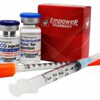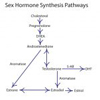By Lee Meyers
“Venous leakage.” Sounds nasty, doesn’t it? Kind of like a hemorrhage or something, eh? Well, most guys would probably rather have a little hemorrhaging than venous leakage, because it leads to weak and/or rapidly disappearing erections.
Venous leakage describes the condition where the blood escapes from the penis and thus a good erection cannot be achieved. An erection begins when penile smooth muscle relaxes enabling blood to infill the corpus cavernosum, two cylindrical “caverns” of spongy tissue running within the penis. Stage two of the erection process occurs with this infilling of the corpus cavernosum. The inflow of blood expands the spongy tissue, which begins to pinch off the emissary veins of the penis, decreasing outflow and – voila! – the erection begins to build.
NOTE: Venous leakage should not be confused with venous insufficiency, which is a condition in which the valves in the lower legs go out due to varicose veins, deep vein thrombosis, etc. There is some evidence that grape seed extract can help with this condition.
Venous leakage occurs when this second stage fails and bloods leaks out as fast as it infills. The “pinching off” of the outflow veins never occurs adequately and, basically, you’re sailing in a leaking boat. Again, though, it’s not really that the veins are leaking but rather that the veins are not receiving proper compression.
Causes of Venous Leakage
The causes for venous leakage can be summarized to several basic underlying conditions: 1) smooth muscle insufficiency and 2) structural changes of the corpus cavernosum. Now, what condition can lead to both of these erection killers? Low testosterone, a.k.a. hypogonadism.
That’s correct – low testosterone is a freight train ride to venous leakage and we’re going to look at why below. Here’s the good news: it doesn’t have to be a one-way train ride – you can get off the train.
1) Smooth Muscle Dysfunction. Researchers now know that testosterone both maintains smooth muscle and the nerves the fire them in the corpus cavernosum. For example, researchers have noted that in castrated animals, the nerve fibers and myelin sheaths around them actually shrink and “wither”. And they have also noted that smooth muscle content in the corpus cavernosum decreased as well. Yes, testosterone affects everything in a male!
2) Corpus Cavernosum Integrity. The research points to the fact that low testosterone can actually affect the connective tissue within the corpus cavernosum. While you are losing smooth muscle, you are also likely gaining more connective tissue, i.e. collagen. The ECM (extracellular matrix) changes for the worse, another structure implicated in erectile dysfunction. This is a sort of “hardening” similar to what causes problems throughout your body. You need for the corpus cavernosum to be flexible and expandable in order to properly compress the outflow.
The bottom line is that researchers have found that in a low testosterone environment, the inside of the penis literally atrophies and is replaced with inelastic, fibrous tissue.
For some of you that have discovered that you lived in a hypogonadal state for years without knowing it, this may be a scary prospect. “Did it do permanent damage?” is the natural question to ask yourself. Below we discuss some study results that show about where venous leakage can occur.
How to Improve Venous Leakage
However, before I write anything else, let me state that the good news is that the studies show that, if testosterone is restored, normal erectile function usually goes with it. This means that the damage could not have been too severe from a long term low testosterone environment and indicates that a significant reversal is usually possible.
Venous Leakage and Testosterone
So what is the magic number at which internal penile damage begins to occur and venous leakage begins to rear its ugly head? In one study, researchers looked at men with venous leakage, all of whom had testosterone < 300 ng/dl (10.2 nmol/l). Obviously, 300 ng/dl and less can be a problem area for many guys. Low Testosterone: How Low is Too Low?
However, could we say, then, that 300 ng/dl is the threshold? Actually, for some men, it is probably higher than that as indicated by one study where all participants had venous leakage and some men had testosterone up to 400 ng/dl. [8] In other words, it depends on the individual, but it is possible that some men will begin to experience damage to the penis at 400 ng/dl (13.6 nmol/l) with still others at 300 ng/dl or even 250.
Is there a solution? Several studies to date have shown that by restoring testosterone to more normal levels, a partial reversal is possible. Of course, just how much of a reversal can be achieved likely depends on many factors, including the number of hypogonadal years as well as various lifestyle factors. The good news is that a study of Russian, low T men with erectile dysfunction and venous leakage showed good results from testosterone therapy. In this study, almost all of these men were unresponsive to PDE5 Inhibitors such as Cialis, Levitra and Viagra and all of them had testosterone below 300 ng/dl (10.2 nmol/l). In spite of their seemingly dire circumstances, about a third of the men were cured through just testosterone therapy alone. Another third were cured through a combination of testosterone and PDE5 Inhibitors. The means that a solid majority of the men were significantly healed of their venous leakage and achieved a substantial reversal with the help of TRT.
By the way, some of you who may not respond well to PDE5 inhibitors, such as Viagra or Cialis, may find that restoring your testosterone via TRT restores your erections for the above reasons. One study looked at hypogonadal males who did not respond to Viagra and found a significant restoration of erectile function after TRT (Testosterone Therapy). Very similar results were found in a study of Cialis non-responders as well. In other words, sometimes the problem is

















